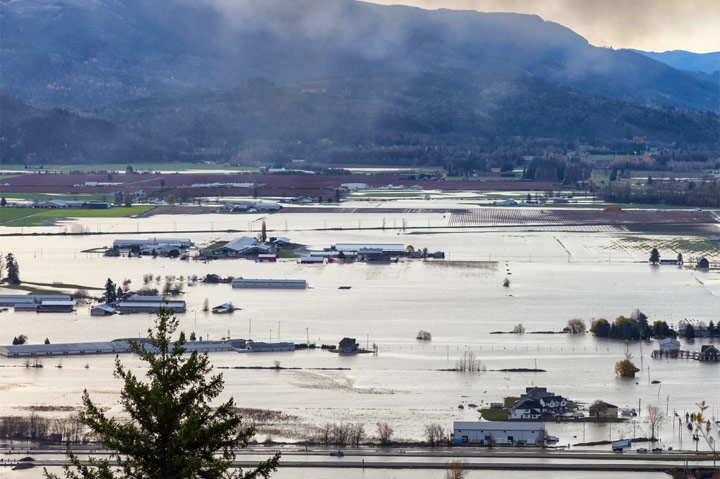CANADIAN NEWS December 08, 2021
Flooding Causes Bottlenecks at the Port of Vancouver
The largest port in Canada is experiencing holdups due to the severe weather. The residual effects are being felt across the country, including in the promo industry.
It’s been an especially difficult year for British Columbia.
Last month, torrential rains led to significant flooding that left six dead (including five in a single landslide), 10 injured and 12,000 displaced, as well as 700,000 livestock animals killed. The waters and landslides also cut off access to critical railways and roads, such as the east-west Trans-Canada Highway, where officials are working to restore full access.

The situation has been so dire that the province is still under a state of emergency after food supply lines were disrupted and officials were forced to ration gas, a policy that’s in place until at least Dec. 14. UPS also temporarily suspended ground service in the province.
Now, the Canadian National and Canadian Pacific railways are working to fix their lines to help relieve massive bottlenecks at the Port of Vancouver, Canada’s largest port and a key entryway for North American goods. Fortunately, Canadian National announced earlier this week that the Kamloops-Vancouver rail corridor is now open, which is critical to move goods to and from the port, but the backlogs persist.
Port operations update #17 - CP and CN mainlines between Vancouver and Kamloops are fully operational. Demand for anchorages continues to exceed capacity. https://t.co/H93EgElafD pic.twitter.com/2rrNhhpMKJ
— Port of Vancouver (@PortVancouver) December 8, 2021
As of Monday, Dec. 6, there were almost 90 vessels at the port, with about half anchored offshore still awaiting berths. Exacerbating the problem are empty containers that can’t be moved; the volume of outbound containers is only about 40% of what it was before the flooding. To relieve pressure, officials have set up a 40-acre site nearby to store empty containers temporarily. But according to the port, demand for anchorages still exceeds capacity, significantly slowing the movement of goods. Normally, about $700 million CN ($548 million US) worth of product move through every day.
“It’s been a trying time here,” says Sam Singh, president and CEO of Full Line Specialties (asi/199688) in Surrey, BC. “First, we had province-wide forest fires in the summer that completely decimated some towns, then we had storm cyclones in October that caused damage, and now the floods and landslides. And on top of that, we’re dealing with a new COVID variant.”
Singh says goods are beginning to move again, but the backlogs started months ago as a result of COVID, along with the fires and massive storms, and have been compounded by recent flooding. “Delivery and fuel costs have increased,” says Singh, “but most people are understanding.”
Now, residual effects of the logjam are being felt across the country during a busy Q4 already plagued by supply chain issues.
“We’re feeling the impact here, specifically on delivery of product and access to time-sensitive ground delivery from the West Coast to Central and Eastern Canada,” says Paul Wieleba, owner of multi-line firm {WE} Promotional Advertising in Ontario. “I got a list of open orders from distributors and made personal calls to communicate about the challenges, with full transparency, and offered solutions. Thankfully, very few canceled and most were understanding. If the past year and a half has taught us anything, it’s that we all need to be patient and understanding about challenges beyond our control.”
“If the past year and a half has taught us anything, it’s that we all need to be patient and understanding about challenges beyond our control.” Paul Wieleba, {WE} Promotional Advertising
Fortunately, the wall-to-wall media coverage has helped to highlight the challenging situation. “In the few instances when we’ve needed to let clients know there’s an issue with their order, the news from there has helped to soften the discussion,” says Cindy Chapman, founder and brand builder at Plan-It Promotions in Ontario, which has donated to flooding relief funds. “It’s a new hurdle in the marathon we’ve all been running since early 2020. Kudos to our resilient suppliers for finding workarounds wherever possible. Our thoughts and prayers are also with the families whose lives have been decimated.”
Hartley Hyman, president of Toba Sportswear (asi/91408) in Winnipeg, says he’s facing challenges shipping into British Columbia. Freight companies still aren’t guaranteeing service times on goods destined for the province. “Many of the products shipped from here since mid-November have gone by Air,” he says. “UPS is now taking ground shipments again, but I’m not sure how long the in-transit time is. Purolator is not yet taking ground shipments from Winnipeg to British Columbia. It’s another challenge in what has been an operationally difficult year.”
Spector & Co. (asi/88660) in Quebec normally receives imports from the port of Prince Rupert, about 1,000 km (620 miles) north of Vancouver, but it too is feeling the pressure. “Dwell time for ships at Prince Rupert is now about 10 to 14 days, which is twice the normal time of five to seven,” says Krista Papagiannopolous, vice president of purchasing. “So, we’re seeing longer times to get goods to rail, and there are still a lot of vessels waiting to be unloaded from both areas, but there’s been progress in recent days.”
Fortunately, Spector preemptively deepened inventory this year to be ready for inevitable hold-ups at ports. “We’re committed to deep levels of stock across all categories, particularly our best-sellers,” says Kippie Helzel, director of business development. “We’ll be able to accommodate what we anticipate will be a robust spring.”
